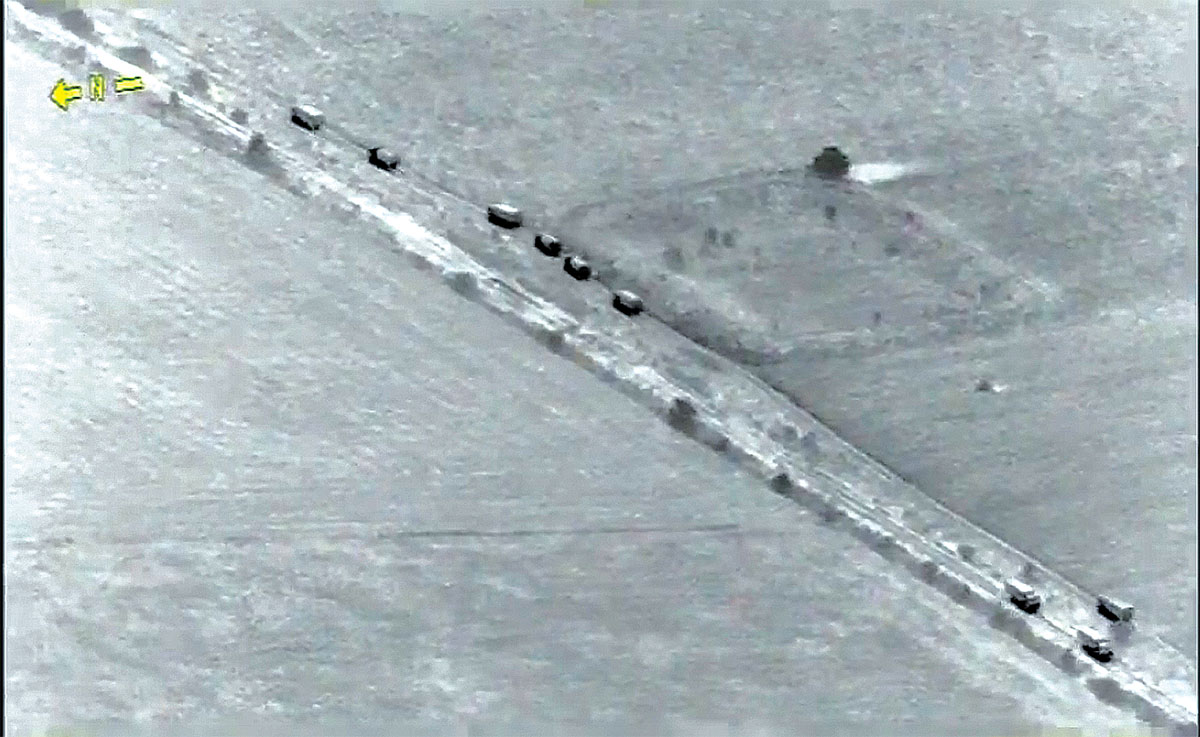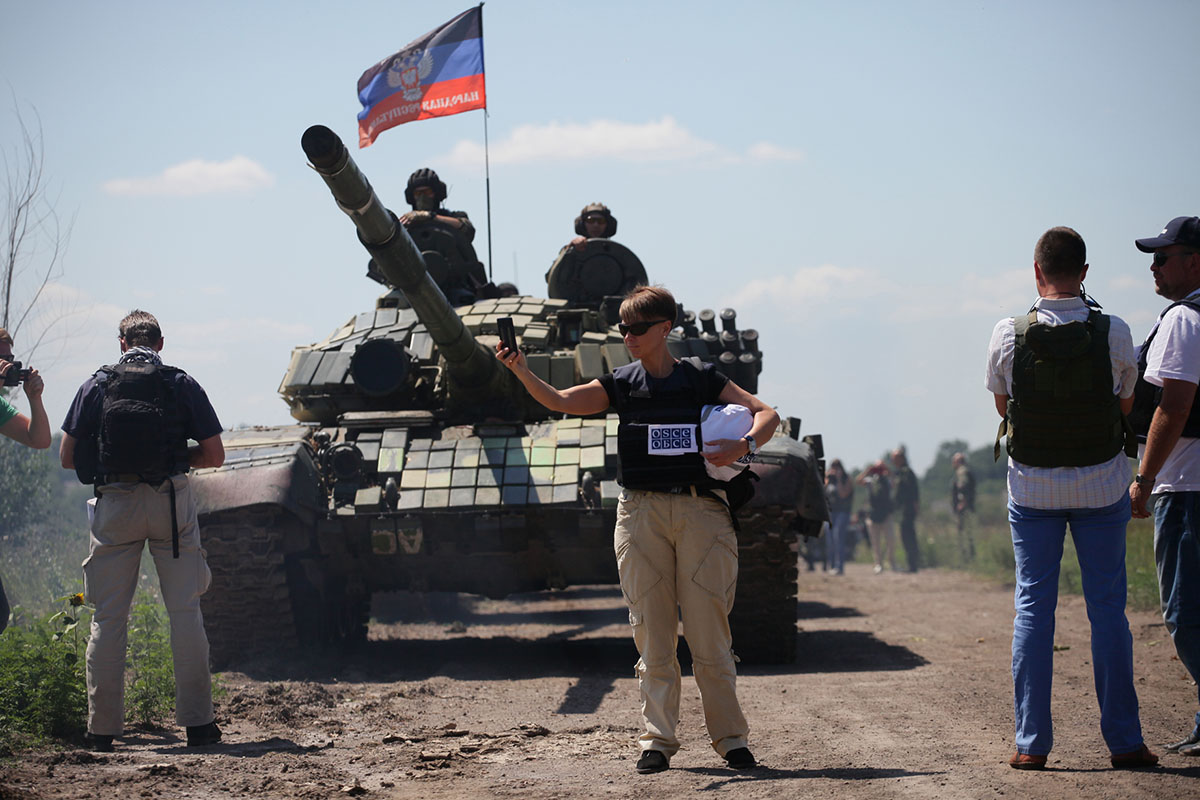Following the principle described by Nazi dictator Adolf Hitler in his book “Mein Kampf,” the Kremlin tells big lies, and tells them often. Bare-faced falsehoods, laced with disinformation and persistent denials, have helped Moscow mask its responsibility for starting a war in Ukraine and continuing it for more than four years.
But the mask is slipping, with the Organization for Security and Cooperation in Europe’s Special Monitoring Mission’s long-range unmanned aerial vehicles recently coming up with a trove of truth that points unmistakably to Russia’s direct military involvement in eastern Ukraine.
The OSCE’s latest reports show that Russia is deploying advanced electronic warfare systems in the Donbas, stockpiling weapons and ammunition, and sending convoys of military trucks between Ukraine and Russia in the dead of night across a section of border Russia controls.
The evidence is piling up that despite its constant denials, Russia is indeed a party to the war in the Donbas, which has claimed over 10,300 lives since 2014.
Military presence
The OSCE’s latest revelations started on Aug. 9, when the organization’s special monitoring mission wrote in its daily report that two days earlier one of its long-range drones had spotted two convoys of heavy trucks entering and exiting Ukraine’s territory through a section of Ukraine’s border with Russia that the Kremlin alone controls. It later released a video of the incident.
The footage showed Kamaz military trucks moving under the cover of darkness along a deserted dirt road near the town of Manych, some 670 kilometers southeast of Kyiv, next to a section of the border with no border-crossing installations.
One of the convoys entered Ukraine and eventually parked in the Russian-occupied city of Khrustalniy, some 655 kilometers southeast of Kyiv after 1 a. m.
The convoy’s cargo was unknown— but on Aug. 10 a mission drone spotted up to 775 ammunition crates, some of which were assessed as new, and 118 more crates of Grad rockets, at a military compound in Khrustalniy.
On the same day, it also saw at least six BM-21 Grad missile systems and eighteen 152-millimeter towed howitzers deployed just 1 kilometer southeast of the munitions dump in the town. But the next revelation by OSCE was even more significant.
On Aug. 11, the mission said it had also spotted on July 28 “four distinct electronic warfare systems” identified as Leer-3 RB-341V, 1L269 Krasukha, and RB-109A Bylina units, as well as a Repellent-1 mobile antidrone system. All of those systems are designed and produced in Russia and were accepted for service exclusively in the Russian army between 2012 and 2017.
They could only have come to Ukraine from Russia. Furthermore, in a recent conversation with the Kyiv Post, the OSCE noted that over the past several months, the mission’s drones had also observed TORN radio intelligence systems in the Russian-occupied part of the Donbas on five occasions.
Four times these Russian-produced systems, on which very little information can be found from open sources, were spotted near the Russian occupied town of Debaltseve, some 600 kilometers southeast of Kyiv (on June 3, 7, 27 and on July 13) and once near the occupied village of Mayorove some 630 kilometers southeast of Kyiv, on July 14, the OSCE said.
All of these radio-electronic and drone warfare systems have been spotted and reported by other sources on multiple occasions.
For instance, Inform Napalm, an international open-source investigations network, published on Sept. 1, 2015 a photo of a TORN unit taken near the destroyed Donetsk Airport.
And early in April 2016, Inform Napalm also posted a video showing a Leer-3 unit in the occupied city of Donetsk. But as the organization mandated under the Minsk peace accords to monitor the situation in the Donbas, the OSCE’s observations carry more weight and credibility.
Against the backdrop of the OSCE revelations, Kurt Volker, the United States Special Representative for Ukraine, accused Russia of using the 400-kilometer uncontrolled section of its border with Ukraine to “sustain conflict.”
“Russia consistently blocks expansion of OSCE border mission, and its forces prevent the SMM from reliably monitoring border as (Russia) sends troops, arms, and supplies into Ukraine,” the U.S. official wrote on his Twitter page on Aug. 12.
“All the while claiming it’s an ‘internal’ conflict and spouting disingenuous arguments about the Minsk agreements.”
Yet even after the latest OSCE revelation, which show Russia to be a party to the war, the organization still employs 37 Russian citizens out of the over 700 OSCE to monitor what is clearly not a civil conflict, but a war on Ukraine prosecuted by Russia.
And in its own reports, the OSCE still does not recognize that Russia is a party to the war, and refers to Russia’s war on Ukraine only as a “conflict.”
Policy of lies
Since the moment Russian President Vladimir Putin greenlighted Russia’s war against Ukraine in early 2014, the Kremlin has flat-out lied about its military intervention in the country.
When first “little green men” appeared in February 2014 on the Crimean soil in full, modern Russian military uniforms, with modern combat gear and equipment, but without any insignia, Putin repeatedly denied what was obvious — that these were Russian soldiers.
Only in April, after Russia conducted a sham referendum and claimed that it had annexed the Ukrainian territory, did Putin grinningly admit his lies.
After that, even as legions of tanks, infantry fighting vehicles, artillery pieces, and troop trucks began to raise dust on country roads as they crossed the Russian-Ukraine border to fight Ukrainian forces, the Kremlin denied that it was waging war in the Donbas.
When a dozen paratroopers from Russia’s 98th Airborne Brigade were taken prisoner and shown in TV news during the Battle of Ilovaisk in August 2014, Russia’s Defense Ministry made the ludicrous claim that their soldiers had “got lost” and entered Ukraine by mistake.
Following the deadly tragedy of Malaysia Airlines Flight MH17, which was shot down by a Russian Buk missile fired in Russian-occupied Donbas in July 2014, with all 298 people aboard killed, the Kremlin tried to muddy the waters by spouting absurd conspiracy theories.
In one, Kremlin media claimed a Ukrainian Su-25 ground attack warplane had shot down MH17 (a theory discounted even by Russian experts.)
In another, Kremlin military intelligence office Igor Girkin, whose team of special operations soldiers launched the Russian takeover of parts of the Donbas, made the bizarre claim that MH17 had actually been full of dead bodies when it was downed, some of which his soldiers had found to be “bloodless.”
The official international investigation in late May 2018 found that MH17 had been shot down by a powerful Russian Buk surface-to-air missile, fired by Buk launcher 332 of Russia’s 53rd Anti-Aircraft Missile Brigade, based in Kursk, Russia.
Investigators called on the Kremlin to admit its responsibility for the crime. It has not yet done so.

A screenshot from OSCE drone video footage shows heavy truck
convoys crossing an uncontrolled section of Russian-Ukrainian border
near the occupied Donetsk Oblast town of Manych. (Courtesy)
And Russia’s policy of lies and denials is not limited to its interference in Ukraine’s affairs. With extraordinary tenacity, Russian representative Vasiliy Nebenzya defended the regime of Syrian dictator Bashar al-Assad during a United Nations Security Council session shortly after a deadly chemical attack in Douma that killed at least 70 people in early April 2018.
Denying much more likely claims by other countries and international monitors that the attack was carried out by Assad’s forces, Russia called the deadly incident “a staged provocation.”
Accused of meddling in the 2016 presidential elections in the United States, Moscow has dismissed the charges as “a regular fake.”
The 17 agencies that make of the intelligence community in the United States have unanimously concluded that Russia attempted to influence the election.
Deception and denial were also Russia’s answer to the doping scandals of 2015–2017, as a result of which Russia was stripped of 13 Olympic medals, and scores of Russian athletes were permanently banned.
And when the British government accused Russia of poisoning Sergey Skripal, a former Russian GRU intelligence officer and subsequently an MI6 double agent, with a Novichok nerve agent in Salisbury, England, the Kremlin again responded with denials and threats.
Nonetheless, it had very little effect, as 18 countries, including Ukraine, kicked out Russian diplomats in late March in response to the Salisbury attack.
Concerning the latest evidence of Russia’s military presence in Donbas given by the OSCE, the Kremlin had not given an official response as of Aug 14.
Its stance on Ukraine remains absolutely the same: total denial if there is a shred of doubt over the evidence, or silence — when denials are obviously false.
That last case applies to the OSCE’s latest reports: It is now obvious that the Kremlin continues to intervene militarily in Ukraine, and fuel the war there.
The only question now is whether the world will finally take firm action against the liars in the Kremlin.

OSCE monitors observe the withdrawal of
Russian-backed troops in a combat area near
the occupied city of Donetsk on July 19, 2015.
(AFP photo)
